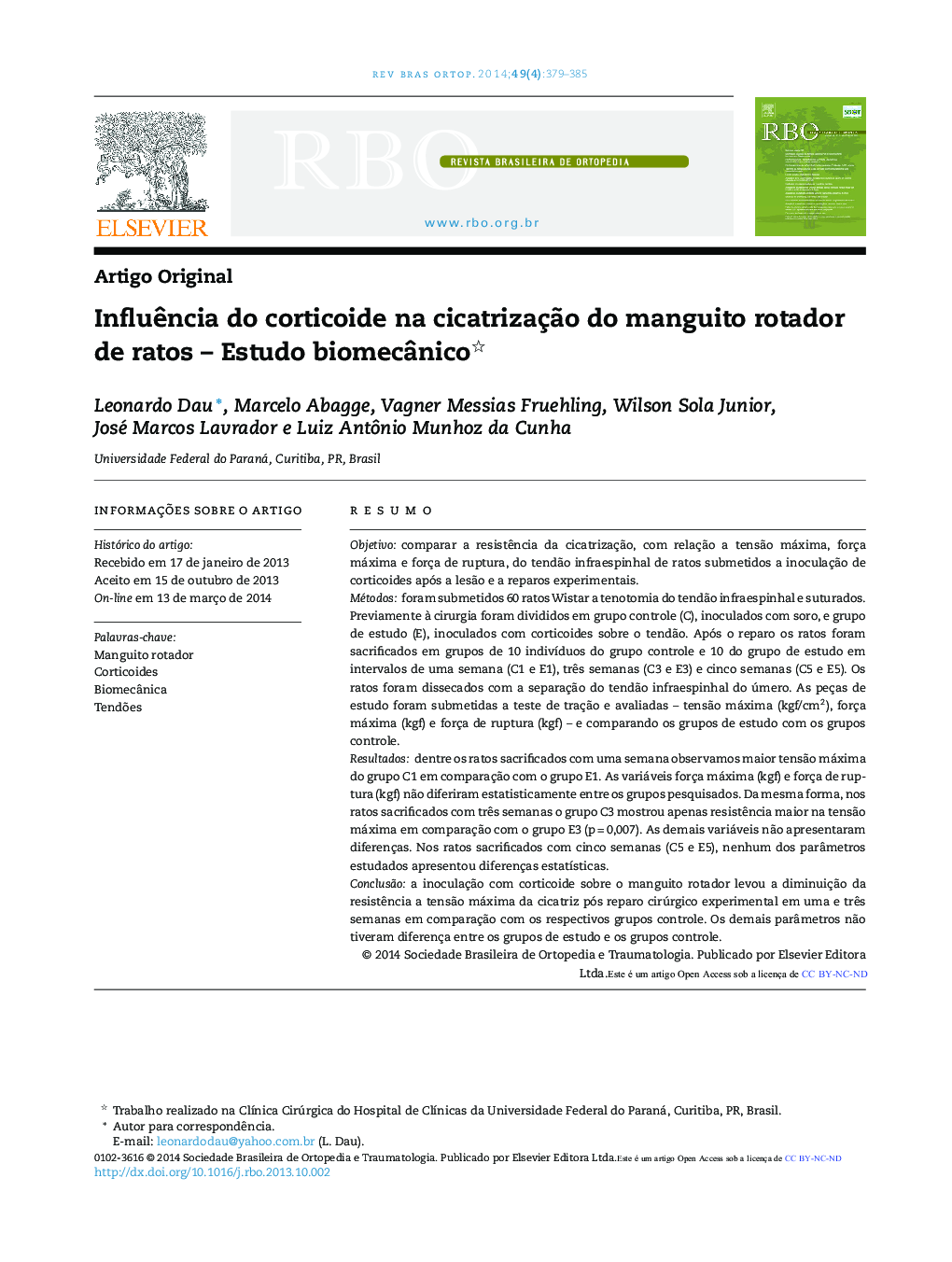| کد مقاله | کد نشریه | سال انتشار | مقاله انگلیسی | نسخه تمام متن |
|---|---|---|---|---|
| 2707543 | 1144859 | 2014 | 7 صفحه PDF | دانلود رایگان |

ResumoObjetivocomparar a resistência da cicatrização, com relação a tensão máxima, força máxima e força de ruptura, do tendão infraespinhal de ratos submetidos a inoculação de corticoides após a lesão e a reparos experimentais.Métodosforam submetidos 60 ratos Wistar a tenotomia do tendão infraespinhal e suturados. Previamente à cirurgia foram divididos em grupo controle (C), inoculados com soro, e grupo de estudo (E), inoculados com corticoides sobre o tendão. Após o reparo os ratos foram sacrificados em grupos de 10 indivíduos do grupo controle e 10 do grupo de estudo em intervalos de uma semana (C1 e E1), três semanas (C3 e E3) e cinco semanas (C5 e E5). Os ratos foram dissecados com a separação do tendão infraespinhal do úmero. As peças de estudo foram submetidas a teste de tração e avaliadas – tensão máxima (kgf/cm2), força máxima (kgf) e força de ruptura (kgf) – e comparando os grupos de estudo com os grupos controle.Resultadosdentre os ratos sacrificados com uma semana observamos maior tensão máxima do grupo C1 em comparação com o grupo E1. As variáveis força máxima (kgf) e força de ruptura (kgf) não diferiram estatisticamente entre os grupos pesquisados. Da mesma forma, nos ratos sacrificados com três semanas o grupo C3 mostrou apenas resistência maior na tensão máxima em comparação com o grupo E3 (p = 0,007). As demais variáveis não apresentaram diferenças. Nos ratos sacrificados com cinco semanas (C5 e E5), nenhum dos parâmetros estudados apresentou diferenças estatísticas.Conclusãoa inoculação com corticoide sobre o manguito rotador levou a diminuição da resistência a tensão máxima da cicatriz pós reparo cirúrgico experimental em uma e três semanas em comparação com os respectivos grupos controle. Os demais parâmetros não tiveram diferença entre os grupos de estudo e os grupos controle.
Objectiveto compare healing strength of the infraspinatus tendon of rats with corticoid inoculation, regarding maximum tension, maximum force and rupture force, after injury and experimental repair.Methods60 Wistar rats were subjected to tenotomy of the infraspinatus tendon, which was then sutured. Before the surgery, they were divided into a control group (C) inoculated with serum and a study group (S) inoculated with corticoids over the tendon. After repair, the rats were sacrificed in groups of 10 individuals in the control group and 10 in the study group at the times of one week (C1 and S1), three weeks (C3 and S3) and five weeks (C5 and S5). The rats were dissected, separating out the infraspinatus tendon with the humerus. The study specimens were subjected to a traction test, with evaluation of the maximum tension (kgf/cm2), maximum force (kgf) and rupture force (kgf), comparing the study group with the respective control groups.Resultsamong the rats sacrificed one week after the procedure, we observed greater maximum tension in group C1 than in group S1. The variables of maximum force (kgf) and rupture force did not differ statistically between the groups investigated. In the same way, among the rats sacrificed three weeks after the procedure, group C3 only showed greater maximum tension than in group S3 (p = 0.007), and the other variables did not present differences. Among the rats sacrificed five weeks after the procedure (C5 and S5), none of the parameters studied presented statistical differences.Conclusionwe concluded that corticoid diminished the resistance to maximum tension in the groups sacrificed one and three weeks after the procedure, in comparison with the respective control groups. The other parameters did not show differences between the study and control groups.
Journal: Revista Brasileira de Ortopedia - Volume 49, Issue 4, July–August 2014, Pages 379–385